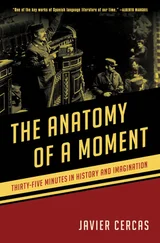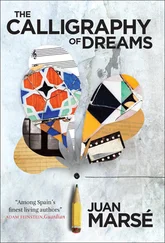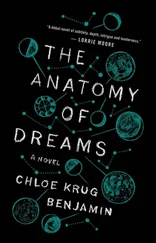It was a simple stimulus-response technique first developed by Carlos Castaneda, a writer and anthropologist. Castaneda reasoned that the dreamer’s body was one of the few elements that did not change between sleep and waking life—and that it could therefore be used to anchor the sleeper in an otherwise changeable dream world, reminding them both of their identity and their state of consciousness.
Jamie kept his burned hand hidden: his elbow bent, the little fingers wedged beneath his torso. He held his other hand up, showing me.
“That’s right. Perfect.”
I stepped back to examine my work. The electrodes were precisely placed and taped; it was why Keller always left this part to me.
“Where did . . .” said Jamie. He paused and looked toward the door. “Where did he go?”
“Gabe? He’ll be back in a moment. We just have to run a few tests to make sure everything is working the way it should be, and then I’ll go get him.”
“What kind of tests?”
“Fun tests,” I said. “Like this. Close your eyes. I’m going to time you, and after thirty seconds you can open them—but no more or less.”
He did so.
“Now open them for thirty seconds. You can blink, but try not to move. Try to be still as a plank of wood.”
Jamie clenched his jaw, his eyes on the ceiling.
We began each session with this series of bio-calibrations to make sure the signals were accurate. I had him look left and right, to mimic the activity of the eyes in REM sleep; cough, which set a standard for snore levels; hold his breath; move his feet; look up and down. When we finished, I looked into the glass window and nodded. I couldn’t see in, but I knew Gabe was there, watching me.
“You passed,” I said. “You were great. Now let’s get you under the covers.”
With the setup complete, Gabe returned from the other room, which meant Keller had taken his place. Jamie lay on top of the bed’s white sheets and blanket, his limbs spread, as we tried to ease the covers over them.
“I don’t want to,” he said.
“Don’t want to?” asked Gabe. “Who ever heard of that? Not sleeping under the covers.”
“I don’t want to do it,” Jamie said, more forcefully. His eyes shifted from Gabe to me.
“You’ll get cold,” I said.
“I won’t.”
“It’s a cold building,” said Gabe. “Very cold down here in this building.”
“I’m not cold.”
Gabe glanced at me, then at the window separating Room 76 from Room 74.
“All right,” he said. “Your choice. We’ll just have to put your belt on this way.”
We started at the end of the bed. I eased the first strap from my side of the bed to Gabe’s, and he buckled it in.
“What are those?” asked Jamie, moving his ankles beneath the lowest strap.
“Seat belts,” said Gabe. “For the rocket ship.”
“The rocket ship?”
“Didn’t anybody tell you this bed is a rocket ship? That’s why it’s so big. And when you fall asleep, it blasts off.”
Gabe was pushing it here, I thought. Even Jamie seemed dubious. But he was silent as we buckled each row of straps.
“And here’s the last thing you need,” I said. “It’s a mask, with special lights inside so you can see the stars. Do you remember what to do, when you fall asleep and see stars?”
“I move my eyes,” said Jamie.
“Exactly,” I said. “Can you show me how?”
He moved his eyes four times, horizontally: left-right, left-right.
“Aren’t you good,” said Gabe.
“When I see my hand in my dream,” mumbled Jamie, “I know I am dreaming.”
He was sleepy now, his left hand unguarded. Up close, the skin was thick and marbled, pink-and-white fingers curling toward his palm. The hand looked so tender, so damaged, that I had the sudden urge to hold it in my own.
“That’s right,” said Gabe. “But they feel real to you, don’t they?”
The boy stared at Gabe, unmoving. I looked sharply across the bed at Gabe, then at the window between the rooms.
“They’re dreams, though,” Gabe added. “Just dreams.”
When I left the room and walked into 74, Keller was sitting stiffly before the window.
“What was that?” he asked.
“I don’t know,” I said, closing the door behind me.
“Likes to push the envelope, that one,” said Keller grimly, picking up a Styrofoam cup. “Coffee?”
“I’m fine,” I said, taking a seat beside him. “Well—what kind?”
“Half-caf. Here.”
He took a thermos from the floor and poured its contents into another Styrofoam cup.
“Thanks,” I said.
Keller nodded. He was in his fifties now, nine years older than he had been when I first arrived at Mills, but he didn’t look much different—he had the same pale skin, the same substantial nose and dark, full eyebrows. I had never seen him with any other facial hair, but he didn’t look gaunt. His features were robust and muscular, his skin lined with idle expressions: two permanent grooves between his brows, crow’s-feet raying out from each eye. His pupils were a striking, aquatic blue, almost cerulean, the irises lined in black. Our patients probably felt he looked severe, but I thought his dynamism also made him handsome.
It wasn’t long before Jamie was asleep, Gabe sitting in the chair beside his bed. He flipped through the Isthmus , our local paper.
“Must have been tuckered out,” said Keller, inching his chair closer to the window.
We allowed Jamie to sleep through the first REM cycle. Eight minutes after the next cycle began, Gabe put the newspaper on the floor and gave us a thumbs-up. I triggered the light stimulus—eight flashes in two seconds, transmitted through the LEDs in Jamie’s sleep mask.
We waited, Keller and I in Room 74 and Gabe in Room 76, still as he could make himself.
There was no response. Keller tapped his Styrofoam cup on the table.
“I’ll try again in two minutes,” I said.
Gabe relaxed, though he leaned forward again when two minutes had passed. I triggered the light flashes. Jamie stirred slightly, shaking his head, but he didn’t move his eyes.
“He’s not lucid,” muttered Keller, leaning back in his chair.
There was a brief murmur in the EEG. Jamie had moved his eyes to the left, then to the right.
“Wait,” I said. “He might be.”
Keller craned over the machine.
“Only happened once,” he said. “It could be random. We can’t count it as an LR2 unless we get both movements.”
“We’ll try at the next cycle,” I said. Gabe looked at the window and raised his eyebrows; then he left the room and came into 74.
“How long do I have?” he asked.
“About an hour, if his last cycle was any indication,” I said.
“Right. I’ll be back in fifty minutes.”
He left to retrieve his dinner from Keller’s office. Keller and I sat alone at the desk. In the other room, Jamie was serene, his chest filling and deflating. Keller and I sank into a comfortable silence, watching him as if in meditation. After a long stretch, Keller shifted in his chair and stretched backward, his back cracking.
“Liking the new place?” he asked.
“It’s not bad,” I said. “Sort of an empty neighborhood, but at least it’s quiet.”
“Don’t you have a dog park around there?”
“Brittingham. It’s pretty. Would be better if I had a dog.”
“But you do,” said Keller. “That’s where you take Gabriel. Let him run around.”
He laughed, and so did I.
“What about you?” I asked. “Cottage Grove, right?”
It was its own small village, close to the Dane County airport and Blackhawk Airfield. Keller had had us over for dinner when we joined him in Madison, back in August, but we hadn’t been back since; we saw him so frequently that sometimes it felt like we all lived together, here in the basement of the neuroscience building.
Читать дальше












